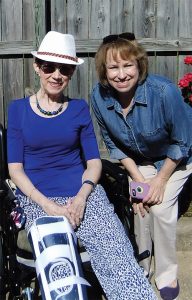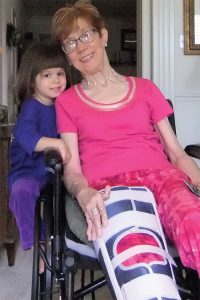I encountered healthcare workers who assured me, “You don’t need to use that. Just grab onto my neck, and I can move you myself.” I politely refused to do this, knowing my upper extremities are weaker than the normal patient’s.

The author with her friend, Lisa Veregge, RN, BSN, taking a walk.
I learned that it is an RA patient’s responsibility to discern whether the exercises prescribed are appropriate for the complex deficits many of us have. What may be safe and appropriate for most orthopedic patients may be unsafe and put excessive stress on an RA patient’s weakened joints. It was my job to discuss and explore with my therapist whether the exercises prescribed safely met my needs. It was a chance to educate others about the unusual needs we RA patients have. The hospitalist who cared for me remarked, “You can tell me how to care for you.”
At the time of this writing, it has been three weeks since my ORIF procedure. The extensive surgical wound on the lateral aspect of my right thigh is well approximated and only slightly tender. I am healing well.
This has not always been the case, however. Many RA patients, including myself, have difficulty with normal wound healing. As a veteran of more than 20 trips to the operating room since 1983, I always prided myself on how well my body could heal with no complications. It took a minor surgery in 2015 to prove me wrong. I discovered a small mass on my upper left thigh, and with my history of two cancer diagnoses, I knew it should not be ignored. A core needle biopsy report showed no malignancy. It described acute areas of reactive fibrosis, fibrovascular proliferation and foamy macrophages, compatible with abscess. I underwent an incision and drainage (I & D) of my thigh abscess. My post-operative course was unremarkable until I noticed purulent drainage oozing from my supposedly healed wound. I was hospitalized with septicemia caused by streptococcus pneumoniae. My wound was reopened twice more because it did not heal properly A referral to a wound clinic was made, and it was there that I learned that RA patients may have difficulty with wound healing. This is yet another possible complication of the RA disease process that must not be ignored.
New Challenges Present

The author with her granddaughter, Kate.
